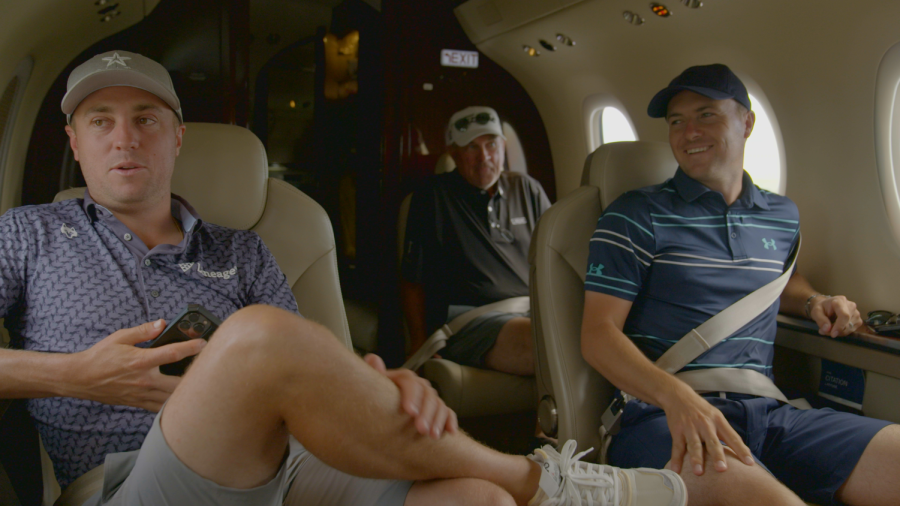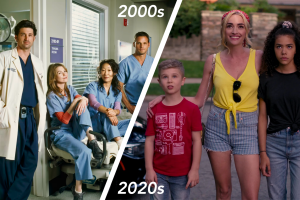For the most part, “Full Swing” is a swing and a miss
Best friends Justin Thomas (left) and Jordan Spieth (right) jokingly engage in trash talk.
March 21, 2023
From interesting stories, touching moments and funny jokes to excruciatingly awkward exchanges and dramatic scenes, Netflix’s newest docuseries, “Full-Swing,” has it all.
Modeled after “Drive to Survive,” the highly successful Formula 1 documentary series, “Full-Swing” follows the lives of professional golfers as they try to balance the challenges of the game with their private lives during the 2022 season.
As a golf enthusiast, I was excited to witness the behind-the-scenes life of professional golfers that I’d never seen before. I was also eager to see how the documentary would tackle the many storylines that defined the golf world in 2022. Specifically, I was curious how much of a platform it would give the Saudi-backed LIV Golf tour and the players who made the controversial decision to join it.
But, once I started watching the series, I noticed one major problem that hampered its success: none of the player profiles fit into any larger story or narrative.
In reality, each episode focused on one or two players that were either stars or personable journeymen. While this format worked occasionally, the show would have been better off featuring a little of every player in each episode instead of each player showing up once and never being seen or heard from again.
Along similar lines, the show should have been told in chronological order to avoid returning to the same tournaments, which made the narratives repetitive immediately. That way, the natural flow of the story would have been more effective and each episode could have provided unique insight.
The show also missed an opportunity to let the realities of the players’ lives tell the story, failing to take advantage of private footage from the player’s homes that could have captured raw emotion. When the show did tap into those natural stories, I was hooked. There were a few players, namely self-deprecating Joel Dahmen and family man Tony Finau, that shined. Dahmen’s episode reveals his grieving process for his mother’s loss from cancer, his relationship with his caddie and his battle with cancer. This story, paired with his unique attitude toward his golf game, made for a compelling episode.
I was inspired by Finau’s perseverance through his rough upbringing and his prioritization of his family over golf. Like Dahmen’s episode, Finau’s centers around the loss of a family member: while on tour, he takes time to support his wife, whose mother passed away during the filming of the show. It was heartwarming to see behind-the-scenes clips of Finau spending time with his family and was satisfying to watch him win back-to-back tournaments to silence those who criticized his “family-first” mentality. The episodes that featured personable golfers were no doubt the strongest because they contained relatable stories that were fascinating and original.
When the show shied away from those natural stories, it was a disaster. There were a few episodes where I thought the storylines were forced, such as the episode featuring best friends Jordan Spieth and Justin Thomas. Episodes like this left me feeling empty because I hadn’t learned anything new after nearly 45 minutes of watching.
Episodes also fell short when players came across as extremely entitled. Collin Morikawa, for example, complained about his glove size, the clothes he had to wear and the air around him, all while lounging on his private jet heading to the most exclusive golf course in the world. It was that exact moment when the series was at its lowest. Producers used clips from players like Morikawa and tried to turn it into a story, but they failed miserably. It felt like another dreaded forced narrative, which was the show’s clear downfall. When the narratives could be told through the golfer’s perspectives and emotions on the course, the show contained dramatic substance and genuine character. But when the show tried to force a storyline that didn’t exist between players, the show was an unmitigated disaster.
Overall, my excitement and anticipation for the documentary series raised my expectations to an unrealistic level, but nevertheless, the show as a whole was immensely disappointing. Some storylines made the show impossible to stop watching, but unfortunately, the majority of the show featured characters and narratives that were simply boring or forced.
According to Netflix, a second season is in the works for 2024. Hopefully, it will include the return of some heroes from season 1 and drop the disappointing characters, otherwise, the second season will be even worse than the first.
If you are a golf fan, I recommend you watch “Full Swing” because the behind-the-scenes moments are fresh and unexpected, but when the final credits roll, expect to be left wanting more.










































